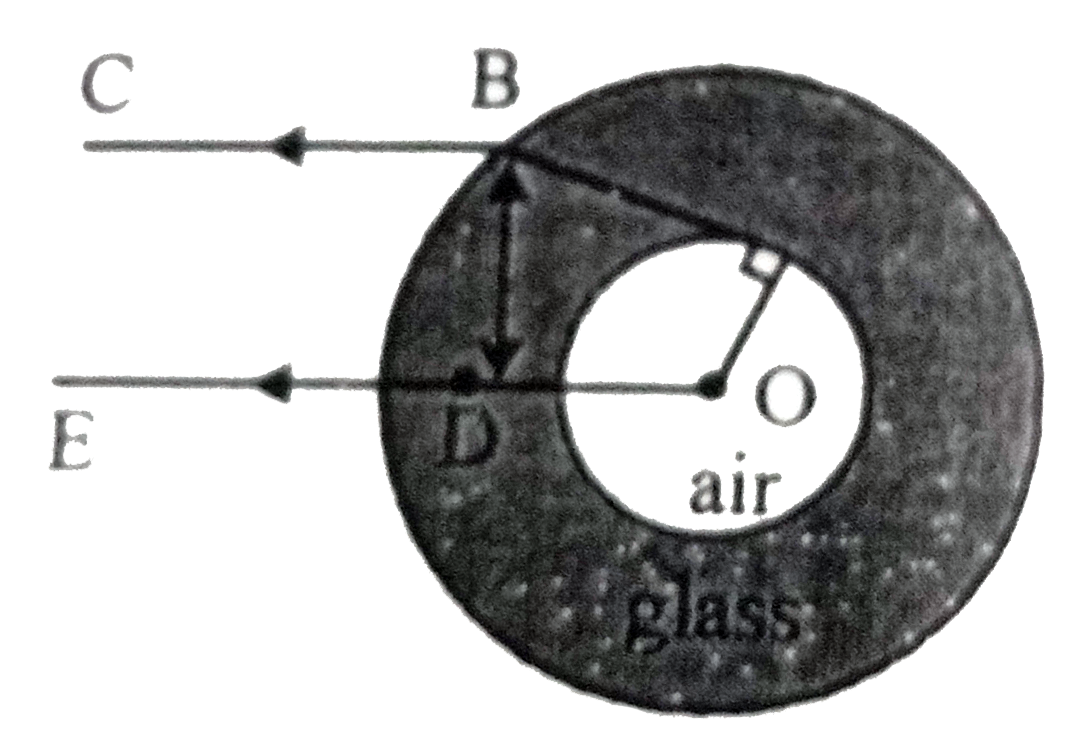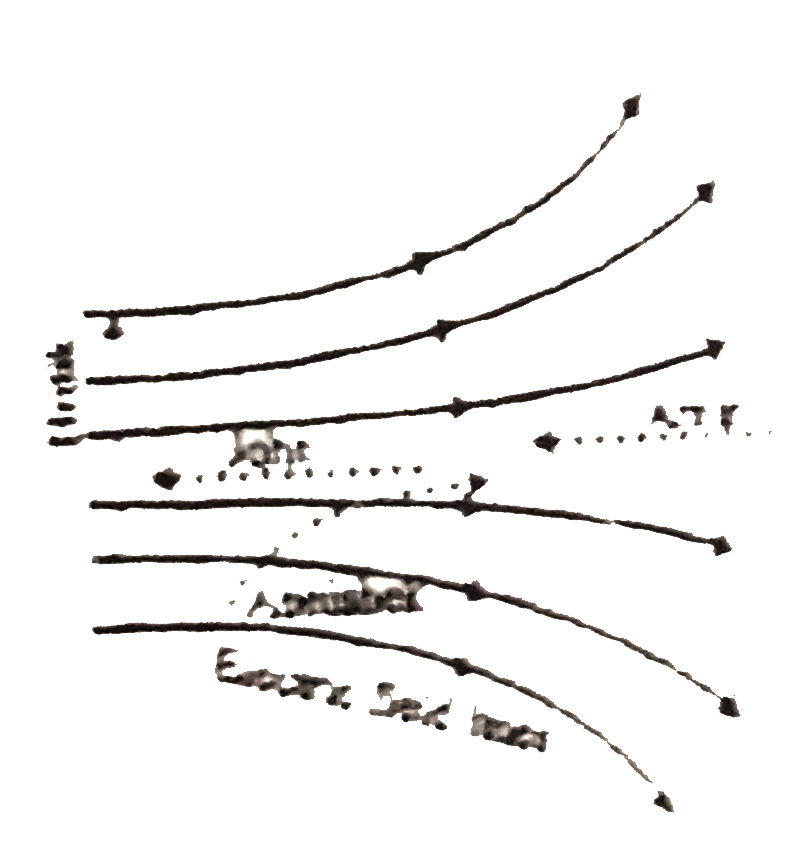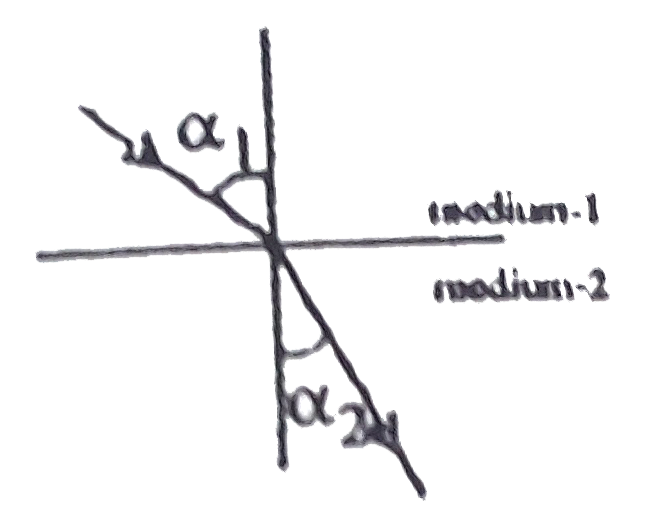Complete Solutions to PHYSICS SECTION - 1 PART-A [SINGLE CORRECT CHOICE TYPE] of chapter TEST PAPERS of Class 12 book with complete answers and questions
| Class 12 | MATHS |
| Chapter | TEST PAPERS |
| BANSAL | PHYSICS SECTION - 1 PART-A [SINGLE CORRECT CHOICE TYPE] |
| Number Of Questions | 18 |
| Academic Year | 2023-24 |
The adjacent figure shows cross section of a hollow glass tube of internal radius r, external radius R and index of refraction n. For two rays DE and ABC (in which De lies ODE and DE is parallel to BC), the separtion `r_(1)` will be

View SolutionA beam of light from medium 1 to medium 2 to medium 3 as shown in the diagram. What may be concluded aboul the three indices of refraction `n_(1),n_(2)andn_(3)` ?

View SolutionA ray of light passes through a prism whose refracting angle is `5^(@)` and dispersive power is 0.03. The refractive index for the mean ray in a spectrum is 1.62. The mean deviation and angle of dispersion respectively are
View SolutionLight is incident at an angle `phi` with the normal to a plane containing two slits of separation d. Select the expression the correctly describes the positions of the interference maximum in terms of the incoming angle `phi` and outgoing angle `theta`.

View SolutionIn a Young's Double slit experiment, the slits are illuminted by monochromatic light. The entire set up is immersed in pure water. Which one of the following act CAN NOT restore the original fringe width.
View SolutionAbhishek, Hritik, John, and Amir are assigned the tasks of moving equal positive charges slowly through an electric field, along assigned path (shown as dotted line). In each case the charge is rest at the beginning.
They all have paths of exactly equal lengths. Who must do the most positive work ?

View SolutionCharge Q is given a displacement `vec(r)=ahat(i)+bhat(j)` in an electric field `vec(E)=E_(1)+E_(2)hat(j)`. The work done
View SolutionThe phenomenon of interference demonstrates the fact that :
View SolutionA total charge Q is distributed over two concentric hallow uniform sphere of radii a and b, `(bgta)` such a way that their surface charge densities are qual. The potential at the common centre is given by :
View SolutionA double convex lens made of glass `(mu=1.5)` is immersed in water `(mu=4//3)`. If its focal length in air is 'F', then the focal length in water will be :
View SolutionA beam of light propagates through a medium-1 and falls onto another medium-2 at an angle `alpha_(1)` as shown. After that it propagates in medium-2 at angle `alpha_(2)` as shown. The light's wavelength in medium-1 is `lamda_(1)`. What is the wavelength of light in medium-2 ?

View SolutionIn a Young's double slit experiment, the separation between the slits is d, distance between the slit and screen is `D(Dgtgtd)`. In the interference pattern, there is a maximum exactly in front for each slit. Then the possible wavelength (s) used in the experiment are
View SolutionIn a double slit experiment, two parallel slits are illuminated first by light of wavelength 400 nm and then by light of unknown wavelength. The fourth order dark fringe resulting the known wavelength of light falls in the same place on the screen as the second order bright fringe from the unknown wavelength. The value of unknown wavelength of light is
View SolutionThe maximum electric field at a point on the axis a uniformly charged ring is `E_(0)`. At how many points on the axis will be magnitude of electric field be `E_(0)//2`
View SolutionAn electric depole moment `vec(p)` is oriented parallel to a uniform electric field `vec(E)`, as shown.

It is rotated to one the four orientations shown below. Rank the final orientations according to the change in the potential energy of the dipole-field system, most negative to most positive.

View SolutionIf g is the acceleration due to gravity on the earth's surface the change in the potential energy of an object of mass m raised from the surface of the eacrth to height to the radius R of the earth is
View SolutionTwo glass slabs of same thickness are joined to form an L as shown. A ray is incident on the combination as shown (in the plane of paper). The final emergent ray will

View SolutionWhen an object is kept at a distance of 30cm from a concave mirror, the image is formed at a distance of 10 cm. If the object is moved with a speed of `9cm s^(-1)` the speed with which the image moves is
View Solution
PHYSICS SECTION - 1 PART-A [SINGLE CORRECT CHOICE TYPE] questions and complete solutions for chapter TEST PAPERS of BANSAL MATHS (HINGLISH) of Class 12
All Exercises from BANSAL Class 12 MATHS TEST PAPERS
- CHEMISTRY
- CHEMISTRY SECTION - 2 [PARAGRAPH TYPE]
- CHEMISTRY SECTION - 2 PART A [SINGLE CORRECT CHOICE TYPE]
- CHEMISTRY SECTION - 2 [MULTIPLE CORRECT CHOICE TYPE]
- CHEMISTRY SECTION-2 PART-A [MULTIPLE CORRECT CHOICE TYPE]
- CHEMISTRY SECTION-2 PART-A [SINGLE CORRECT CHOICE TYPE]
- CHEMISTRY SECTION-2 PART-C [INTEGER TYPE]
- Chemistry SECTION-2 (PART-A) [PARAGRAPH TYPE]
- CHEMISTRY SECTION-2 Part-A ( Multiple correct choice type )
- CHEMISTRY SECTION-2 Part-A ( paragraph type )
- CHEMISTRY SECTION-2 Part-A ( Reasoning type )
- CHEMISTRY SECTION-2 Part-A ( single correct choice type )
- CHEMISTRY SECTION-2 Part-B ( Matrix type )
- CHEMISTRY SECTION-2 Part-C ( Integer type )
- Chemistry, SECTION-2 (PART-A) [MULTIPLE CORRECT CHOICE TYPE]
- Chemistry, SECTION-2 (PART-A) [REASONING TYPE]
- Chemistry, SECTION-2 (PART-A) [SINGLE CORRECT CHOICE TYPE]
- Chemistry, SECTION-2 (PART-B) [MATRIX TYPE]
- Chemistry, SECTION-2 (PART-C)
- Math
- MATHEMATICS
- Mathematics SECTION-3 (PART-A) [COMPREHENSION TYPE]
- Mathematics SECTION-3 (PART-A) [RESONING TYPE]
- Mathematics SECTION-3 (PART-A) [SINGLE CORRECT CHOICE TYPE]
- Mathematics, SECTION-3 (PART-A) [MULTIPLE CORRECT CHOICE TYPE]
- Mathematics, SECTION-3 (PART-B) [MATRIX TYPE]
- Mathematics, SECTION-3 (PART-C)
- Mathenatics
- MATHS
- MATHS SECTION - 2 [MULTIPLE CORRECT CHOICE TYPE]
- MATHS SECTION - 2 PART A [PARAGRAPH TYPE]
- MATHS SECTION - 2 PART A [SINGLE CORRECT CHOICE TYPE]
- MATHS SECTION-3 PART-A [SINGLE CORRECT CHOICE TYPE]
- MATHS SECTION-3 PART-B [MULTIPLE CORRECT CHOICE TYPE]
- MATHS SECTION-3 PART-C [INTEGER TYPE]
- MATHS SECTION-3 Part-A [ comprehension type ]
- MATHS SECTION-3 Part-A [ Multiple correct choice type ]
- MATHS SECTION-3 Part-A [ single correct choice type ]
- MATHS SECTION-3 Part-A [Reasoning type ]
- MATHS SECTION-3 Part-B[ Matrix type ]
- MATHS SECTION-3 Part-C[ Integer type ]
- PHYSICS
- PHYSICS SECTION - 1 [MULTIPLE CORRECT CHOICE TYPE]
- PHYSICS SECTION - 1 PART-A [SINGLE CORRECT CHOICE TYPE]
- PHYSICS SECTION - 1 PART-B [MULTIPLE CORRECT CHOICE TYPE]
- PHYSICS SECTION - 1 PART-C [INTEGER TYPE]
- PHYSICS SECTION - 1 [PARAGRAPH TYPE]
- PHYSICS SECTION-1 Part-A ( Multiple Correct Choice type )
- PHYSICS SECTION-1 Part-A (Comprehension type )
- PHYSICS SECTION-1 Part-A (Reasoning type )
- PHYSICS SECTION-1 Part-A (Single Correct choice Type )
- PHYSICS SECTION-1 Part-B [Matrix Types]
- PHYSICS SECTION-1 Part-C (Integer Type )
- Physics, SECTION-1 (PART-A)
- Physics, SECTION-1 (PART-A) [COMPREHENSION TYPE]
- Physics, SECTION-1 (PART-A) [MULTIPLE CORRECT CHOICE TYPE]
- Physics, SECTION-1 (PART-B) [MATRIX TYPE]
- Physics, SECTION-1 (PART-C)